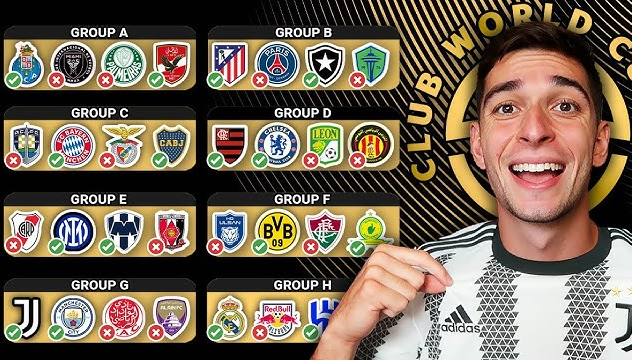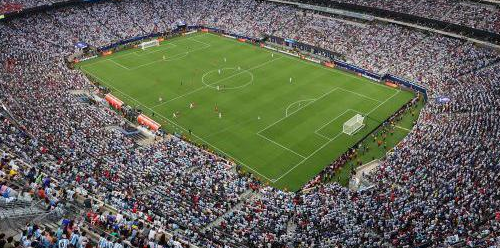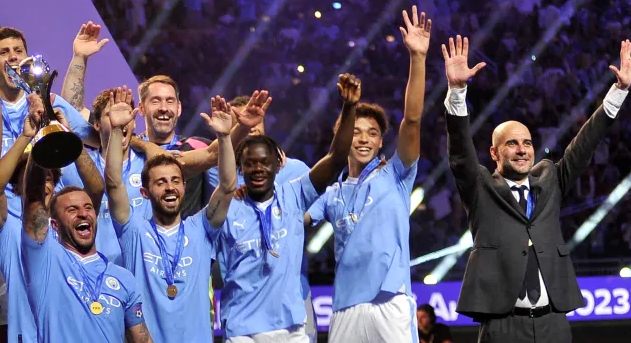Predictions for the 2025 FIFA Club World Cup Final
 The 2025 FIFA Club World Cup Final stands as one of the most anticipated events in global football, bringing together the best club teams from across continents to battle for ultimate supremacy. With the competition set to reach its pinnacle in July 2025, fans, experts, and data analysts are already generating their own final predictions. This year’s tournament is unique, not only for the expanded format but also for the growing interplay between data-driven predictions and footballing intuition. As the world turns its attention to the FIFA Club World Cup 2025 final date, excitement grows for what promises to be a dramatic, high-stakes conclusion. Every aspect—from the venue to team line-ups—invites close scrutiny as we explore what could decide the fate of the next world champions. Below, each key element is unpacked, with concrete details, data, and expert opinions to give the most comprehensive preview and prediction for the big day.
The 2025 FIFA Club World Cup Final stands as one of the most anticipated events in global football, bringing together the best club teams from across continents to battle for ultimate supremacy. With the competition set to reach its pinnacle in July 2025, fans, experts, and data analysts are already generating their own final predictions. This year’s tournament is unique, not only for the expanded format but also for the growing interplay between data-driven predictions and footballing intuition. As the world turns its attention to the FIFA Club World Cup 2025 final date, excitement grows for what promises to be a dramatic, high-stakes conclusion. Every aspect—from the venue to team line-ups—invites close scrutiny as we explore what could decide the fate of the next world champions. Below, each key element is unpacked, with concrete details, data, and expert opinions to give the most comprehensive preview and prediction for the big day.
Date and Venue of the Semi-Finals
The semi-finals of the FIFA Club World Cup final predictions mark the final hurdle before the ultimate match in Miami. This year’s venues were chosen for their world-class facilities, crowd capacity, and ability to deliver a first-rate spectator experience. Each stadium has hosted elite international matches, adding to the sense of occasion. The timing of the matches has also been set to maximize global television audiences and accommodate fans from all participating regions.
Below is a detailed schedule for the semi-finals and final, including exact locations and timings:
| Event | Date | Time (UTC) | Venue | City | Capacity |
| Semi-Final 1 | July 8, 2025 | 18:00 | MetLife Stadium | New Jersey | 82,500 |
| Semi-Final 2 | July 9, 2025 | 21:00 | Mercedes-Benz Stadium | Atlanta | 71,000 |
| 3rd Place Playoff | July 12, 2025 | 16:00 | Hard Rock Stadium | Miami | 65,000 |
| Final | July 12, 2025 | 20:00 | Hard Rock Stadium | Miami | 65,000 |
- All venues are equipped with state-of-the-art turf, lighting, and spectator amenities.
- The final’s kick-off time on July 12, 2025, aligns perfectly for prime-time viewing in the Americas and convenient hours for fans in Europe, Africa, and Asia.
Teams that Have Advanced to the Final
The 2025FIFA Club World Cup final will feature two clubs who have conquered their respective continental tournaments and excelled throughout the group and knockout stages. After battling through a packed schedule and diverse opponents, these finalists have earned their places through tactical discipline, individual brilliance, and deep squad depth. Evaluating their squads, strengths, weaknesses, and FIFA ratings provides crucial insights for anyone interested in informed FIFA Club World Cup final predictions.
| Team | Key Players | Strengths | Weaknesses | FIFA Club Rating |
| Real Madrid CF | Bellingham, Vinícius Jr., Tchouaméni, Rodrygo | Possession play, experience, set pieces, squad depth | Occasional high defensive line, transition vulnerability, overreliance on wingers | 92 |
| Al Ahly SC | Afsha, Tau, El Shennawy, Dieng | Counterattack, defensive organization, pace, resilience | Depth beyond starting XI, struggles vs. intense pressing, aerial duels | 88 |
- Real Madrid CF, a perennial powerhouse, brings creative midfielders, clinical finishers, and a history of delivering under pressure. Their technical mastery and ability to control tempo often see them as favorites in FIFA Club World Cup final predictions.
- Al Ahly SC, the African champions, counter with rapid transitions, organized defensive lines, and a team chemistry that frustrates even the strongest opponents. They excel at absorbing pressure and striking with lethal pace.
Teams Overview: All 2025FIFA Club World Cup Participants and Tournaments
The path to the final is shaped by clubs representing every major confederation tournament.
| Confederation | 2025 Entrants (Sample) | Qualifying Tournament |
| UEFA | Real Madrid CF, Manchester City | UEFA Champions League |
| CONMEBOL | Fluminense, Palmeiras | Copa Libertadores |
| CAF | Al Ahly SC, Wydad Casablanca | CAF Champions League |
| AFC | Urawa Red Diamonds, Al Hilal | AFC Champions League |
| CONCACAF | Club América, Monterrey | CONCACAF Champions Cup |
| OFC | Auckland City FC | OFC Champions League |
| Host League (USA) | Inter Miami CF | MLS Cup Champions |
- The diversity of these entrants ensures a wide range of playing styles and football cultures in the tournament.
- Each team had to overcome fierce continental competition before earning their place in the world finals.
Clash of Styles: What Will Decide the Final
 When elite teams collide, tactics often outweigh individual brilliance. The FIFA Club World Cup final predictions are expected to showcase a true clash of football philosophies. Real Madrid’s technical, possession-based play will face the aggressive, counterattacking system of Al Ahly SC. The final could be decided by whichever side imposes its will for longer periods and reacts best to key moments.
When elite teams collide, tactics often outweigh individual brilliance. The FIFA Club World Cup final predictions are expected to showcase a true clash of football philosophies. Real Madrid’s technical, possession-based play will face the aggressive, counterattacking system of Al Ahly SC. The final could be decided by whichever side imposes its will for longer periods and reacts best to key moments.
The importance of tactical discipline cannot be overstated. In previous finals, even the smallest lapses in structure have been ruthlessly punished. Therefore, coaches are focusing on how to balance attacking ambition with defensive security, and adaptability will be a defining factor in the outcome.
Possession-Based Play vs. Counterattacking
Possession-oriented football emphasizes control, passing sequences, and probing for gaps in the opposition. Real Madrid are specialists in dictating tempo, using their midfielders to orchestrate attacks and reduce the opponent’s time on the ball. However, this strategy can leave them open to rapid counters—something Al Ahly exploit with speed and directness. In matches where Madrid dominate possession, they must remain vigilant against turnovers, as Al Ahly are among the best in the world at launching quick, multi-man counterattacks.
Set Pieces and Defensive Reliability
Set pieces have historically been pivotal in finals. Real Madrid’s height and technical set-piece takers present a constant threat from corners and free-kicks. Al Ahly are equally capable, with rehearsed routines and physically strong defenders. Defensive reliability, however, goes beyond set pieces—it encompasses focus, communication, and the ability to recover from mistakes. Teams that maintain defensive composure under pressure are far more likely to lift the trophy.
Scenario-Based Predictions
Every final is defined by scenarios—who scores first, who responds better to setbacks, and who makes key tactical adjustments. With both teams possessing clear identities, the direction of the match will be shaped by early developments. For those making FIFA Club World Cup final predictions, scenario analysis is essential.
If Real Madrid take an early lead, their ability to manage possession and slow the tempo may stifle Al Ahly’s comeback hopes. If Al Ahly score first, the pressure will be on Madrid to commit more players forward, potentially exposing them to counterattacks. The match could also hinge on late drama, extra time, or penalties, given the high stakes and evenly matched squads.
If the Favorite Scores Early
An early goal by the favorites (Real Madrid) would dramatically change the dynamic. Al Ahly would be forced out of their comfort zone and would need to attack more aggressively, potentially leaving them vulnerable at the back. Madrid could then control the tempo and exploit spaces with patient passing. Conversely, desperation from Al Ahly could lead to defensive errors or open up opportunities for Madrid to seal the game with a second goal.
Numbers vs. Instinct: Data Meets Passion
 Modern football predictions blend analytics and human judgment. Big data, artificial intelligence, and advanced scouting reports allow for the most accurate and nuanced 2025 FIFA Club World Cup final result in history. At the same time, the unpredictability of finals keeps instinct and experience relevant.
Modern football predictions blend analytics and human judgment. Big data, artificial intelligence, and advanced scouting reports allow for the most accurate and nuanced 2025 FIFA Club World Cup final result in history. At the same time, the unpredictability of finals keeps instinct and experience relevant.
Data analysts provide managers with insights on every conceivable variable, from opposition patterns to player fatigue. However, great coaches and players still make crucial decisions based on “feel”—how the game is evolving in real time, beyond what any spreadsheet can capture.
Artificial Intelligence and Prediction Statistics
AI models aggregate past and current data to calculate probabilities for match outcomes, individual performances, and in-game events. These tools consider factors such as historical performance, head-to-head results, and current squad fitness. For the 2025 FIFA Club World Cup final, AI-powered predictions put Real Madrid as favorites but highlight Al Ahly’s significant counterattacking threat. These statistics feed directly into public and expert FIFA Club World Cup final predictions but do not guarantee the result.
Expert Opinions and Intuition
Despite technological advances, intuition from pundits, former players, and managers remains influential. Experts consider intangible factors—team chemistry, psychological readiness, or weather conditions—that numbers can’t fully quantify. The best predictions blend both approaches, respecting data without ignoring the unpredictable human side of football.
Substitute Factors That Can Change Everything
No matter the preparation, football finals often hinge on unpredictable elements. Injuries, substitutions, red cards, and VAR decisions can all flip the script. Teams that manage these disruptions with composure and flexibility typically triumph, regardless of pre-match odds or data-driven predictions.
Both finalists will have contingency plans, but adaptability during the game remains crucial. These “wild card” factors keep fans and analysts alike glued to every second of the FIFA Club World Cup final predictions.
Injuries, Red Cards, and VAR Drama
Finals are often remembered for game-changing moments—key injuries, a controversial sending-off, or a pivotal VAR call. The physical and mental strain of such a high-stakes match can result in lapses or overreactions. Teams need disciplined leaders to steer them through these challenges. For viewers, these moments contribute to the unique drama and unpredictability that make the FIFA Club World Cup final so captivating.
Comparison with Past Finals
Studying previous FIFA Club World Cup finals reveals patterns that inform current predictions. European teams have typically dominated but have not always had easy victories. Some finals have been one-sided, while others have seen underdogs come within a whisker of glory. The 2025 final, featuring a traditional powerhouse and a resilient challenger, continues this rich narrative.
Experience, composure, and tactical flexibility have been key traits of past winners. Analyses of these factors offer useful perspective when formulating FIFA Club World Cup final predictions.
Previous Club World Cup Finals
Historical finals show that while European sides often triumph, there have been moments of real drama and close encounters. Clubs like Chelsea, Bayern Munich, and Liverpool have all lifted the trophy in recent years, but teams like Raja Casablanca and Kashima Antlers have run them close. Lessons from these matches—on managing nerves, adjusting tactics, and capitalizing on moments—are invaluable for 2025 finalists.
| Year | Winner | Runner-Up | Score | Key Moment |
| 2015 | Barcelona | River Plate | 3-0 | Messi’s opener |
| 2017 | Real Madrid | Grêmio | 1-0 | Ronaldo free-kick |
| 2018 | Real Madrid | Al-Ain | 4-1 | Early goal by Modrić |
| 2019 | Liverpool | Flamengo | 1-0 (AET) | Firmino’s extra-time winner |
| 2020 | Bayern Munich | Tigres UANL | 1-0 | Pavard’s winner |
| 2022 | Chelsea | Palmeiras | 2-1 (AET) | Havertz’s penalty |
| 2023 | Manchester City | Fluminense | 2-0 | De Bruyne masterclass |
| 2024 | Real Madrid | Al Hilal | 3-1 | Vinícius Jr’s double |
FAQ
Can an underdog really beat a favorite in a one-off final?
Why is the momentum of the semi-finals so important for the final?
What is the difference between data-driven predictions and predictions based on “gut feelings”?
Data-driven predictions rely on numbers and trends; gut feelings reflect intuition and past experience.


